
The sexual response cycle refers to a series of physical and emotional phases that occur when an individual becomes aroused or engages in sexually stimulating activities. Sexual stimulation during such activities is not limited to penile-vaginal intercourse. The full sexual response cycle can be experienced during masturbation, manual stimulation by one’s partner, oral sex, or fantasy. A comprehensive knowledge and understanding of the physiological changes that the body undergoes during a sexual encounter can help enhance your sexual experiences, deepen the relationship with a partner, or resolve the origins of a sexual problem.1
The stages of the sexual response cycle are a general guideline, so every person’s subjective experience varies. Each person should allow their body to progress through its natural responses, without becoming preoccupied with reaching checkpoints in the cycle. Focusing on the body’s sexual response may distract from the pleasure of the moment and can lead to “spectatoring,” a phenomenon where a person feels like they are a third person in the room, watching and commenting on their own sexual responses.1 Avoid setting expectations and simply enjoy the moment.
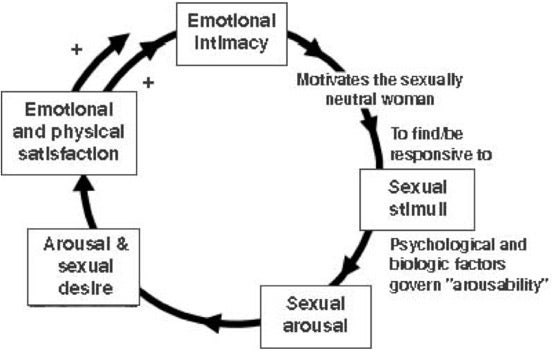
Table of Contents
Masters and Johnson’s Four-Phase Model
The Masters and Johnson’s four-phase model is one of many sexual response models. This model includes an excitement stage, which incorporates an emotional component that is often necessary for some people to reach orgasm.2 Both sexes experience each phase of the Masters and Johnson’s model, but the duration of each phase varies for different sexes and between individuals. With communication, partners can better understand the differences in each other’s sexual response cycles and enhance their sexual experiences.
Phase 1: Excitement
The excitement phase is the beginning of arousal. Whether from partnered sexual activity or solo masturbation, the characteristics of excitement remain the same.1
- Myotonia (muscle tension increases)
- Heart rate and blood pressure increases
- Breathing accelerates
- Skin becomes flushed, blotchiness may appear on the chest and back
- Nipples become erect
- Vasocongestion (increased blood flow to the genitals, increased vascular blood flow, and a localized increase in blood pressure) causes erection in male’s penis and female’s clitoris
- Vaginal lubrication begins and the labia majora begin to swell and separate
- Female breasts enlarge
- Male testes swell and the scrotum tightens
It is important to note that these processes, such as the erection of the penis and lubrication of the vagina, happen at varying rates from person to person and even for the same person on a different day. An erection may take 10 seconds or several minutes. Factors that affect the sexual response cycle include general health problems, age, and libido.1,4
Phase 2: Plateau
In the plateau phase, sexual excitement continues to grow. Note that the word “plateau” is usually used to describe a leveling-off, or an area of no change. In the sexual response cycle, however, the “plateau” is not a static, boring place. In this stage, both males and females experience powerful surges of sexual excitement or pleasure. This phase can be very brief, typically lasting a few seconds to a few minutes.
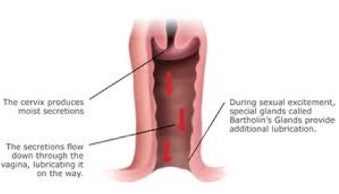
- Muscle tension spasms continue in the feet, hands, and face
- Heart rate, blood pressure, and breathing rate all continue to increase
- The female clitoris becomes highly sensitive and retracts under the clitoral hood to avoid direct stimulation or contact
- The male testes withdraw into the scrotum
- The outer third of the vagina becomes especially engorged with blood and turns a dark purple color
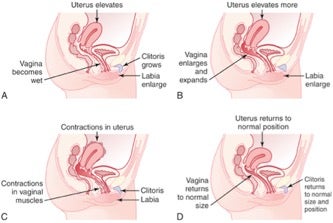
There is no clear point at which a person visibly shifts from the excitement phase to the plateau phase. In the plateau phase, the general characteristics of the excitement phase continue, but become more intense.1 Many people find that extending the length of the plateau period can lead to more intense orgasms.
Phase 3: Orgasm
Orgasm is the climactic, shortest phase of the sexual response cycle, typically lasting only several seconds.1 The general characteristics of this phase of the sexual response cycle are the same for males and females, with a few notable differences.
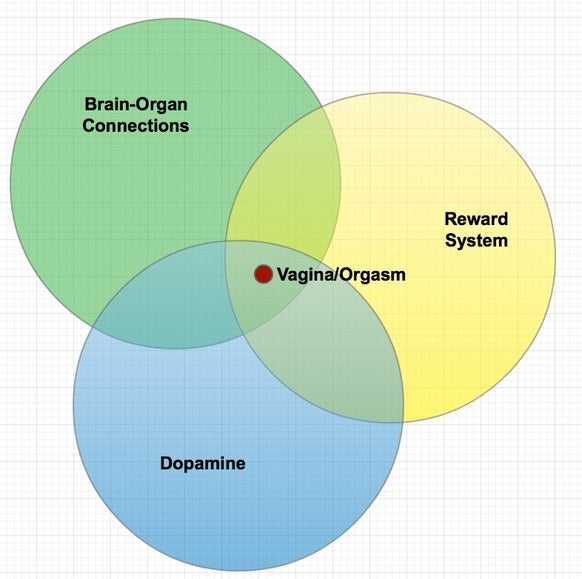
- Muscles involuntarily contract, including spasms of the feet
- Heart rate, blood pressure, and breathing rate peak
- Flush may appear over the entire body
- Muscle tension releases
- In a female, the vaginal muscles contract and the uterus undergoes repeated contractions
- In a male, repeated contractions occur at the base of the penis and semen is ejaculated
While females can have a longer orgasm than males, the sensations of orgasms do not seem to differ by biological sex; that is, males and females feel similar things during orgasm. In one study, college students provided descriptions of orgasms. Researchers compared the descriptions using a standard psychological rating scale, and there were no distinguishable differences between the male and female descriptions. Both males and females tended to describe orgasms with similar words or phrases such as “waves of pleasure in my body,” referring to the rhythmic muscle contractions that occur during orgasm. In an earlier study, 70 expert judges could not reliably differentiate between the orgasm reports of males and females.1
Some women are capable of achieving multiple orgasms within minutes of the first one. A study done on 805 college-educated females found that almost half of them had achieved multiple orgasms at some point in their lives, from either masturbation or partnered sexual activity.4 Men are usually unable to go into a second orgasm before entering the refractory period in Phase 4.
Instead of thinking about orgasm as a major goal of sex, try focusing on the many other pleasurable feelings and aspects that come with a sexual interaction! It is perfectly okay to not reach orgasm with every experience. You may find that once your mind is free of worry, an orgasm may come with ease! In addition to relaxing your mind, increasing the time spent on foreplay helps as well. Oral sex and manual stimulation of the clitoris or penis are two methods of foreplay that may increase the likelihood of orgasm. However, every person is different and it is important to take time and explore your body to find out what works best for you!
Phase 4: Resolution
In this phase, the body slowly returns to its original, unexcited state. Body parts return to their normal size and hue. Some of the changes occur rapidly, whereas others take more time. The resolution phase is often accompanied by a general sense of well-being, intimacy, and fatigue. The resolution phase begins immediately after orgasm if there is no additional stimulation.
Refractory Period
The refractory period is one of the more significant differences between the sexual response cycle of males and females. The refractory period occurs during the male’s resolution phase. It is defined as the length of time during which a male cannot become aroused from any kind of sexual stimulation. This period can last from a few minutes to several days, depending on the male’s age, frequency of sexual activity, and additional factors.1
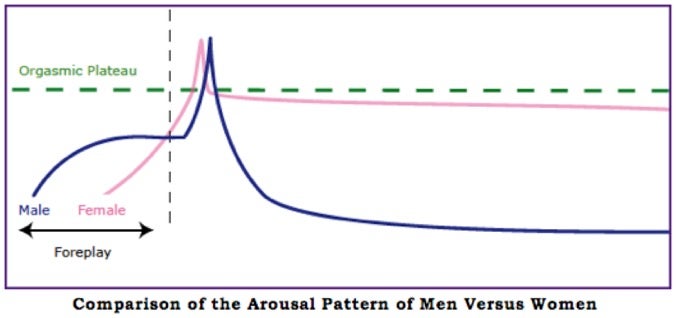
Difficulties in Sexual Response
Sexual dysfunction is a term used to describe any problem throughout the sexual response cycle that prevents a person from enjoying the experience. Studies show that sexual dysfunction is quite common and affects sexually active people of all ages, but tends to be a more prevalent issue for adults over 40 years old. Almost half of all females and about 30% of males have experienced some type of sexual dysfunction. If you are having difficulties, know that you are not alone and treatment options are available.3
Here are some examples of sexual dysfunction:
- Disinterest or lack of desire for sex
- Difficulty with physical arousal
- For men- Difficulty with erection, ejaculation, and orgasm
- For women- Insufficient vaginal lubrication, pain during coitus, and difficulty achieving orgasm
- Medical conditions

Anorgasmia, the persistent inability to achieve orgasm despite responding to sexual stimulation, is also a very common sexual difficulty. Often times this is due to psychological causes rather than a physical inability to orgasm. To understand more about females struggling to reach orgasm, please read this article.
Sexual satisfaction can improve with a healthy lifestyle, an understanding of your body, and effective communication with your partner.3
Concluding Remarks
Masters and Johnson’s model breaks down the physical and emotional phases throughout a sexual experience cycle. A person can complete a full cycle from masturbation, manual stimulation by one’s partner, oral sex, or fantasy. The model begins with excitement phase, continues through plateau and orgasm, and ends with resolution. Understanding the physiological changes the body undergoes throughout the sexual response cycle can help enhance one’s sexual experiences and strengthen the connection between partners.
Resources
- LeVay, Simon, et al. Discovering Human Sexuality. 3rd ed., Oxford University Press, 2015.
- The Cleveland Clinic Foundation. “Sexual Response Cycle.” Cleveland Clinic, 1 Oct. 2017.
- The Cleveland Clinic Foundation. “Sexual Dysfunction.” Cleveland Clinic, 24 Jan. 2015.
- Laumann, E O, et al. “Sexual Problems among Women and Men Aged 40–80 y: Prevalence and Correlates Identified in the Global Study of Sexual Attitudes and Behaviors.” Nature News, Nature Publishing Group, 24 June 2004.
Last Updated: 13 February 2018.
